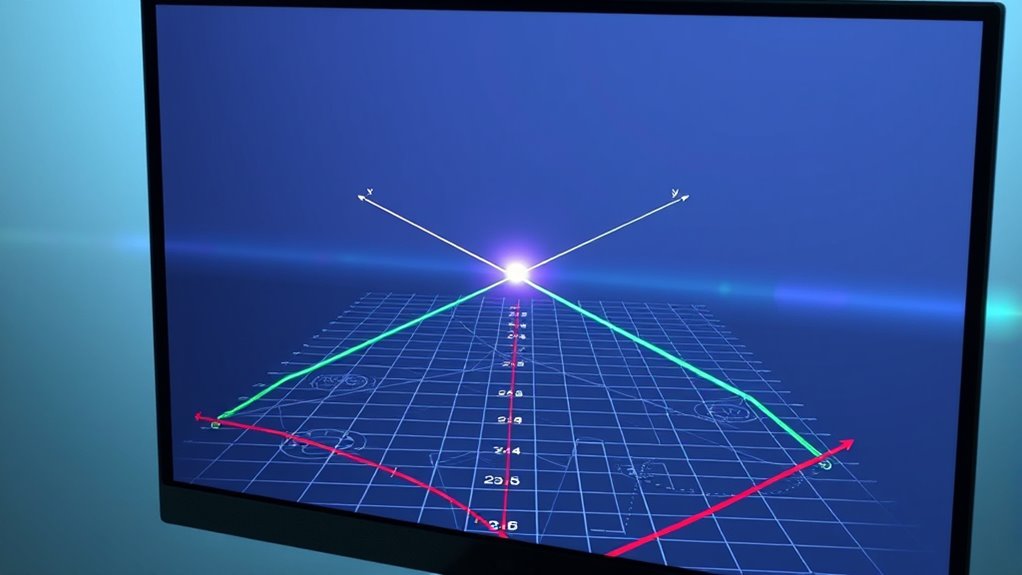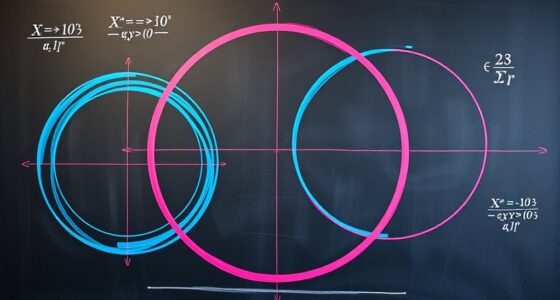In 3D coordinate geometry, you analyze lines and planes using vector algebra, equations, and parametric forms. You determine relationships like intersection, parallelism, and skew lines by examining their direction vectors and normal vectors. Calculating distances from points to planes involves projections onto normal vectors. Understanding these concepts helps in visualizing and solving spatial problems. If you explore further, you’ll gain deeper insights into how these elements interact in three-dimensional space.
Key Takeaways
- Lines in space are represented by parametric equations using a point and a direction vector.
- Planes are defined by a point and a normal vector, with their equation derived from the dot product.
- The normal vector determines the plane’s orientation and helps calculate distances from points to the plane.
- Parallel, intersecting, and skew lines are distinguished by comparing their direction and normal vectors in space.
- Visualizing and analyzing lines and planes in 3D coordinate geometry is essential for applications in engineering, graphics, and physics.
Coordinates and Equations of Lines in Space

Understanding the coordinates and equations of lines in space is essential for analyzing three-dimensional geometry. You use vector algebra to describe lines with a direction vector and a point through which the line passes. This approach helps you derive parametric equations that specify the line’s position in space. For example, if you know a point (P_0(x_0, y_0, z_0)) and a direction vector (vec{d} = langle a, b, c rangle), you can write parametric equations as (x = x_0 + at), (y = y_0 + bt), and (z = z_0 + ct). These equations give you a clear, flexible way to describe any line in space, making it easier to analyze intersections, distances, and relationships with other geometric objects. Additionally, understanding coordinate systems is crucial for visualizing and solving spatial problems effectively.
Understanding Planes in Three-Dimensional Space

To understand planes in 3D space, you need to grasp how their equations are derived from points and vectors. The normal vector plays a key role, as it determines the plane’s orientation. Recognizing its significance helps you better analyze and visualize the plane’s position. Additionally, understanding the role of vector algebra is essential for deriving equations of planes and understanding their spatial relationships.
Plane Equation Derivation
Deriving the equation of a plane in three-dimensional space involves finding a formula that relates any point on the plane to a known point and its normal vector. You start with a point ( P_0 ) and a normal vector ( vec{n} ). To get the plane’s scalar equation, you use the dot product of ( vec{n} ) with any point ( P ) on the plane, resulting in ( vec{n} cdot (vec{r} – vec{r_0}) = 0 ). Vector cross products help find the normal vector when given two vectors on the plane. The scalar equation is then expressed as ( Ax + By + Cz + D = 0 ). This process guarantees you derive a precise formula that captures the plane’s orientation and position in space. Additionally, understanding the geometric interpretation of the normal vector enhances comprehension of how the plane is oriented in space.
Normal Vector Significance
A normal vector plays an essential role in defining a plane’s orientation in three-dimensional space. It indicates the direction perpendicular to the plane, making it crucial for understanding plane orientation. The normal vector’s significance lies in its ability to determine the plane’s tilt and position. When you have a normal vector, you can quickly find the plane’s equation and understand how it relates to other geometric elements. Here’s a quick overview:
| Normal Vector Significance | Plane Orientation | Key Application |
|---|---|---|
| Defines perpendicularity | Determines tilt | Finding plane equations |
| Indicates direction | Shows plane tilt | Analyzing spatial relationships |
| Simplifies calculations | Helps in visualization | Calculating angles between planes |
Additionally, understanding the orientation of planes is fundamental in 3D coordinate geometry, as it helps visualize and interpret spatial relationships more effectively.
Determining the Intersection of Lines and Planes

When working with lines and planes, you need to identify whether they intersect or are parallel. You’ll learn how to determine their relationships using specific calculation methods. Understanding these concepts helps you analyze their points of intersection or confirm their parallelism. Additionally, recognizing the geometry of space allows for more precise analysis of spatial relationships.
Parallel Lines and Planes
Understanding how to determine the intersection of lines and planes is essential in 3D coordinate geometry, especially when dealing with parallel structures. When lines or planes are parallel, they either never meet or coincide, which affects your analysis. Recognizing rotational symmetry can help you understand these relationships, especially when applying coordinate transformations to simplify the problem. To analyze parallelism:
- Check if the direction vectors of lines are scalar multiples.
- Verify if the normal vectors of planes are proportional.
- Use coordinate transformations to rotate or translate the system, making it easier to visualize parallelism.
- Additionally, understanding the geometric properties of these structures can assist in accurately identifying their relationships and intersections.
Intersection Calculation Methods
To determine the intersection of a line and a plane, you need to find the point that satisfies both their equations simultaneously. First, express the line in parametric form and substitute these coordinates into the plane’s equation. To confirm the intersection, you can analyze vector projections to see if the line’s direction vector aligns with the plane’s normal vector. The angle between lines helps determine if they intersect or are skew; if the angle is zero or 180 degrees, they’re parallel, and no intersection occurs. If the vectors are not perpendicular, you can solve for the parameter to find the exact point of intersection. Using these methods, you efficiently identify whether and where a line intersects a plane in three-dimensional space. Additionally, understanding vehicle tuning techniques can provide insights into optimizing performance and handling characteristics in various applications.
Parallel and Skew Lines: Properties and Differences

Parallel and skew lines are fundamental concepts in 3D coordinate geometry, and distinguishing between them is essential for analyzing spatial relationships. Parallel lines never intersect and have the same direction vectors, even if they are in different planes. Skew lines, however, do not intersect and are not parallel; they exist in different planes. For example, space diagonals of a cube are skew lines, exhibiting unique skew line properties. Understanding these differences helps you identify the lines’ orientation and position. To clarify:
- Parallel lines are coplanar and share the same direction vectors.
- Skew lines are non-coplanar and do not share direction vectors.
- Space diagonals often serve as examples of skew lines, illustrating their unique properties in 3D space.
- Recognizing whether lines are parallel or skew involves examining their spatial orientation and relative positions, which is critical for accurate geometric analysis.
Recognizing these distinctions is key to mastering spatial relationships.
Distance Between a Point and a Plane

When working with lines and planes in 3D space, calculating the shortest distance between a point and a plane is a common problem. You can solve this using vector projections. First, identify the vector from the point to a point on the plane. Then, project this vector onto the plane’s normal vector. The length of this projection gives you the shortest distance. The distance formula involves the absolute value of the dot product of the point-to-plane vector and the plane’s normal vector, divided by the magnitude of the normal vector. This method guarantees you find the minimal distance efficiently. By understanding vector projections and applying the distance formulas, you can accurately measure how far a point is from a plane in 3D space. Additionally, contrast ratio plays a vital role in visual clarity when visualizing 3D models or geometric diagrams.
Applications of 3D Coordinate Geometry in Real-World Problems

Have you ever wondered how 3D coordinate geometry helps solve real-world problems across various fields? It’s essential for tasks like navigation, engineering, and computer graphics. Here’s how:
- Coordinate transformations allow you to switch between different coordinate systems, making data compatible across platforms.
- Vector projections help in analyzing forces, optimizing structures, and understanding directional relationships in physics and engineering.
- In robotics, 3D coordinate geometry enables precise movement calculations and spatial awareness, ensuring robots operate accurately in space.
Frequently Asked Questions
How Do 3D Coordinate Systems Differ From 2D Systems?
You might wonder how 3D coordinate systems differ from 2D ones. In 3D systems, you gain depth perception, allowing you to understand spatial relationships more accurately. This enhances your spatial reasoning, helping you visualize objects in space. Unlike 2D, which only uses x and y axes, 3D adds a z-axis, providing an extra dimension. This makes it easier to interpret real-world objects and navigate complex environments effectively.
What Are Common Challenges in Visualizing 3D Geometric Objects?
When visualizing 3D geometric objects, you might struggle with depth perception and spatial reasoning. These challenges make it hard to interpret how objects relate to each other in space, especially from a flat perspective like a screen or paper. You need to develop a mental model to understand spatial relationships, which can take practice. Improving your visualization skills helps you better grasp the complexities of 3D objects and their interactions.
Can 3D Coordinate Geometry Be Applied in Computer Graphics?
Imagine you’re stepping into virtual reality, where 3D modeling brings worlds alive—3D coordinate geometry plays a huge role here. You use it to accurately position and manipulate objects, create realistic scenes, and develop immersive environments. Without it, virtual reality and computer graphics would lack precision. So, yes, 3D coordinate geometry is essential in computer graphics, helping you design, visualize, and bring complex scenes to life efficiently.
How Do Transformations Affect Lines and Planes in Space?
You’ll find that transformations like reflection transformations and rotation effects critically change lines and planes in space. Reflection flips objects across a plane, altering their orientation, while rotation moves them around an axis, changing their position and angles. These transformations help you manipulate objects precisely, maintaining their shape but changing their location or orientation. Understanding how they affect lines and planes is essential for accurate modeling, animation, and spatial reasoning in 3D environments.
What Are the Practical Uses of 3D Geometry in Engineering?
You might wonder how 3D geometry applies practically, and it truly shapes engineering. You use it in robotic navigation to accurately map environments, ensuring robots move safely and efficiently. Architectural modeling relies on 3D geometry to create precise building designs, visualizations, and structural analysis. This mathematical foundation helps you innovate, optimize, and solve complex spatial problems, making it essential for modern engineering solutions.
Conclusion
Mastering 3D coordinate geometry transforms complex spatial problems into manageable calculations. Did you know that airplanes navigate through space with pinpoint precision using these principles? By understanding lines, planes, and their intersections, you gain the tools to solve real-world challenges in engineering, architecture, and navigation. Keep exploring, and you’ll see how these concepts shape the world around you—making seemingly impossible tasks achievable with mathematical clarity.









